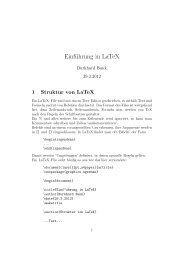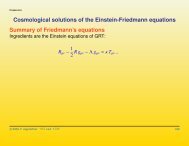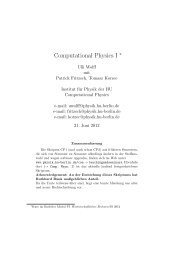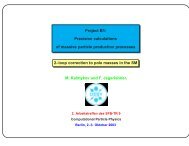Preprint[pdf] - HU Berlin
Preprint[pdf] - HU Berlin
Preprint[pdf] - HU Berlin
Create successful ePaper yourself
Turn your PDF publications into a flip-book with our unique Google optimized e-Paper software.
Protons<br />
from AGS<br />
Target<br />
In Pion Rest Frame<br />
π +<br />
νµ µ +<br />
Pions<br />
p=3.1 GeV<br />
⇒ ⇐ spin<br />
momentum<br />
“Forward” Decay Muons<br />
are highly polarized<br />
Polarized Muons<br />
Inflector<br />
π + → µ + νµ<br />
Storage<br />
Ring<br />
Injection Orbit<br />
Storage Ring Orbit<br />
Injection Point<br />
Kicker<br />
Modules<br />
Fig. 4. The schematics of muon injection and storage in the g − 2 ring.<br />
a neutrino where the muons carry spin and thus a magnetic moment which is directed along the direction<br />
of the flight axis. The longitudinally polarized muons from pion decay are then injected into a uniform<br />
magnetic field � B where they travel in a circle. The ring 5 is a toroid–shaped structure with a diameter of 14<br />
meters, the aperture of the beam pipe is 90 mm, the field is 1.45 Tesla and the momentum of the muon is<br />
pµ = 3.094 GeV. In the horizontal plane of the orbit the muons execute a relativistic cyclotron motion with<br />
angular frequency ωc. By the motion of the muon magnetic moment in the homogeneous magnetic field the<br />
spin axis is changed in a particular way as described by the Larmor precession. After each circle the muon’s<br />
spin axis changes by 12’ (arc seconds), while the muon is traveling at the same momentum (see Fig. 3). The<br />
muon spin is precessing with angular frequency ωs, which is slightly bigger than ωc by the difference angular<br />
frequency ωa = ωs − ωc.<br />
ωc = eB<br />
mµ γ , ωs = eB eB eB<br />
+ aµ , ωa = aµ<br />
mµ γ mµ mµ<br />
, (23)<br />
where γ = 1/ √ 1 − v 2 is the relativistic Lorentz factor and v the muon velocity. In the experiment ωa and<br />
B are measured. The muon mass mµ is obtained from an independent experiment on muonium, which is<br />
a (µ + e − ) bound system. Note that if the muon just has its Dirac magnetic moment g = 2 (tree level) the<br />
direction of the spin of the muon would not change at all.<br />
In order to retain the muons in the ring an electrostatic focusing system is needed. Thus in addition to the<br />
magnetic field � B an electric quadrupole field � E in the plane normal to the particle orbit must be applied.<br />
This transversal electric field changes the angular frequency according to<br />
�ωa = e<br />
�<br />
aµ � �<br />
B − aµ − 1<br />
γ2 �<br />
�v ×<br />
− 1<br />
� �<br />
E . (24)<br />
mµ<br />
This key formula for measuring aµ was found by Bargmann, Michel and Telegdi in 1959 [70,96]. Interestingly,<br />
one has the possibility to choose γ such that aµ − 1/(γ 2 − 1) = 0, in which case ωa becomes independent of<br />
�E. This is the so–called magic γ. When running at the corresponding magic energy, the muons are highly<br />
relativistic, the magic γ-factor being γ = � 1 + 1/aµ = 29.3. The muons thus travel almost at the speed<br />
of light with energies of about Emagic = γmµ ≃ 3.098 GeV. This rather high energy, which is dictated by<br />
the requirement to minimize the precession frequency shift caused by the electric quadrupole superimposed<br />
upon the uniform magnetic field, also leads to a large time dilatation. The lifetime of a muon at rest is<br />
5 A picture of the BNL muon storage ring may be found on the Muon g −2 Collaboration Web Page http://www.g-2.bnl.gov/<br />
14


![Preprint[pdf] - HU Berlin](https://img.yumpu.com/3833433/14/500x640/preprintpdf-hu-berlin.jpg)




